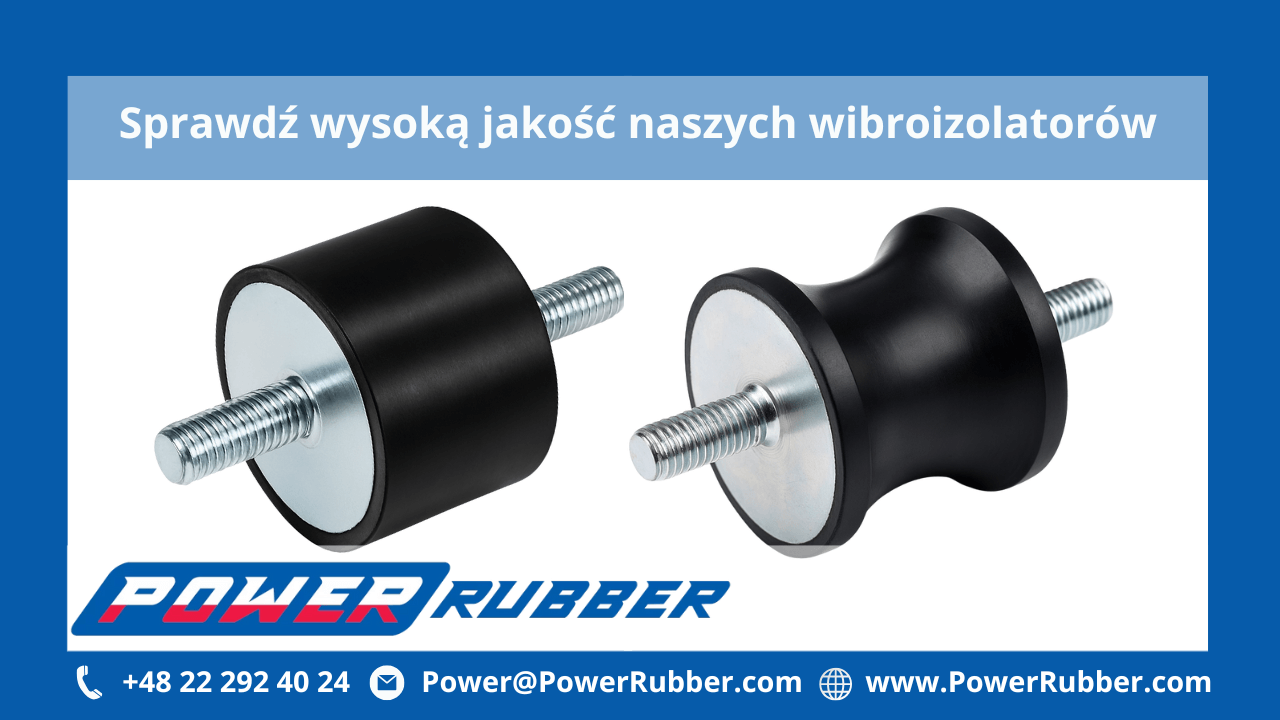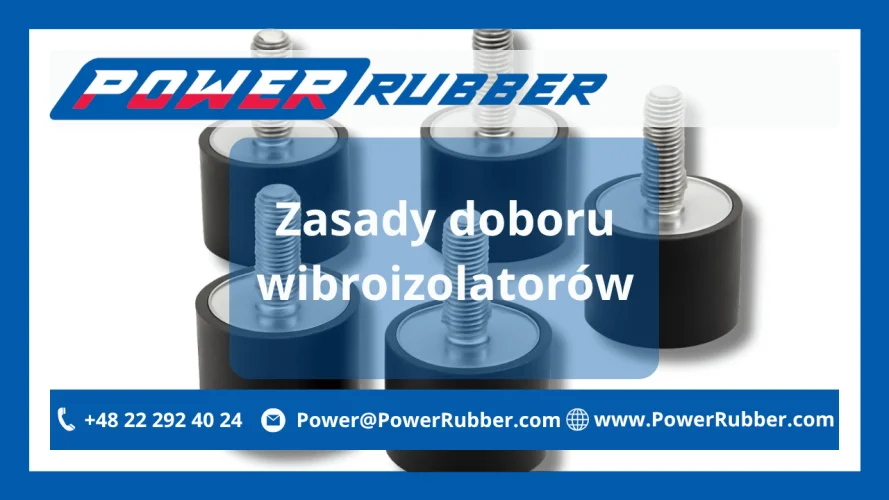Rules for selecting vibration isolators
Machines and devices used in industry, production, and construction can generate significant mechanical vibrations that disrupt their proper functioning, accelerate equipment wear, and emit excessive noise.
Vibration isolation is crucial for protecting equipment, maintaining operational efficiency, ensuring safety, and reducing noise. Excessive vibrations can lead to component damage, failures, and costly repairs. Investing in appropriate vibration isolation solutions is key.
At Power Rubber, we offer high-quality vibration isolators – an effective solution that prevents the transfer of vibrations to floors, walls, and other machines. They protect machines, prevent structural damage, help maintain structural integrity, and minimize undesirable sounds.
What are vibrations?
Vibration is a type of mechanical movement in which an object oscillates around an equilibrium point. It is characterized by frequency, amplitude, and energy. It can be caused by both natural phenomena (earthquakes, wind, ocean waves) and artificial ones, resulting from mechanical movements of machines or tools used by humans that generate vibrations.
Industrial machines produce long-lasting vibrations that affect equipment lifespan, generate undesirable noise, and impact the structural integrity of nearby buildings. To reduce vibration intensity, a low natural vibration frequency of the system is required. To achieve this, the use of rubber isolators is essential.
Impact of vibrations on equipment performance
Uncontrolled vibrations can disrupt machine operation and generate excessive noise. Shocks cause serious damage to mechanical systems, operational problems, shorten equipment lifespan, and negatively impact operational efficiency, as well as employee reliability, safety, and comfort.
What are vibration isolators and what are they used for?
Effective vibration control is the basis for reliable and safe machine operation in an industrial environment. Vibration isolators are designed for effective isolation of vibrations generated during their operation. They are placed between the device and the ground. A suitable vibration isolator minimizes or completely absorbs and dampens the vibration energy transmitted to the ground.
Why is vibration isolation so important?
Operating machines and devices are often exposed to high-frequency vibrations. Vibrations and shocks negatively affect human health, shorten equipment lifespan, and cause damage to structures or entire buildings.
Choosing appropriate vibration isolators brings a number of benefits, including:
- optimal control of vibrations and noise, including structural noise
- mitigation of the impact of excessive noise and vibrations on employee health (quieter and more comfortable work environment)
- improvement of working conditions and quality
- protection of equipment against excessive wear
- reduction in the number of failures, minimization of repair and maintenance costs
- energy efficiency and improvement of operational performance

Selection of vibration isolators for machines and devices
The most important principles to consider when selecting appropriate rubber isolators are described below:
Determining the total weight of the device and the maximum load of the vibration isolator
The weight of the machine directly influences the type and size of the vibration isolator. Each vibration isolator has a specified maximum load range at which it maintains optimal vibration isolation effectiveness. We must know the total weight of the machine to evenly distribute the appropriate number of isolators at various points of the device. The number of vibration isolators depends on the weight and design. The greater the total weight, the larger the mounts must be, or the greater their number needed to reduce machine vibrations. It is important not to overload any of the elements, as this can lead to loss of isolation effectiveness and faster wear.
Vibration characteristics
Excitation frequency and resonance frequency are key parameters when selecting vibration isolators.
- excitation frequency - the frequency at which the device generates vibrations (e.g., engine RPM)
- resonance frequency - should be significantly lower than the excitation frequency to avoid vibration amplification
The ratio of the frequency of the force causing device vibrations to the natural vibration frequency of the isolator directly affects the effectiveness of vibration isolation.
Dynamic loads and number of strokes
In machines with periodically varying forces (presses, compressors), in addition to static mass, dynamic forces must be taken into account. Rubber isolators should be matched to the machine's weight and the vibration frequency it generates during operation. The number of strokes per minute determines the vibration frequency that needs to be effectively dampened. If the machine's vibration frequency approaches the natural frequency of the vibration isolator, resonance may occur, meaning uncontrolled amplification of vibrations instead of dampening them. Therefore, knowing the stroke frequency allows for the selection of the appropriate type of vibration isolator.
Static load
Static load is one of the key parameters that must be taken into account when choosing a vibration isolator. It must be matched to the device's weight and the load distribution across individual support points. Static deflection is the amount by which the vibration-damping mount compresses under the machine's weight. The greater the static deflection, the greater the load it transfers. Exceeding the static load leads to permanent deformation and even damage to the element.
Operating conditions
The environment in which the machine operates is of great importance when choosing an isolator. The selection of a single vibration isolator in terms of temperature fluctuations is crucial for effective vibration dampening and durability. It is important to know the temperature range to which the system will be exposed. Operation at excessively high temperatures can cause degradation of the rubber from which the isolator is made and a loss of damping properties. At low temperatures, elastomers harden, which limits their elasticity.
To properly select a vibration isolator, it is necessary to check whether the material from which it is made is suitable for the specific chemical working environment.
Principles of vibration isolator selection - what else to pay attention to?
The proper selection of vibration isolators (vibration damping elements) aims to choose appropriate components to limit the transfer of vibrations to the building structure or device. As mentioned earlier, the task of vibration isolators is effective isolation from vibrations that can affect the durability and lifespan of machine components and user safety. This is particularly important for rotating machines (e.g., fans), where vibrations occur with high frequency, expressed in Hz or revolutions per minute (RPM).
In the earlier part of the article, we drew attention to a very important issue, namely: comparing the natural vibration frequency of the system with the excitation vibration frequency. Here we want to emphasize that effective vibration isolation requires the natural vibration frequency of the system to be at least 1.4 times lower than the forced vibrations. This is crucial in ensuring an appropriate degree of vibration isolation without affecting the operation of the rest of the system.
The mounting method is also key here. Vibration isolators must be mounted symmetrically with respect to the center of gravity and evenly compressed. The mounting point, i.e., the distance from the vibration axis, is extremely important. In the case of uneven ground, self-leveling vibration isolators are used (they have an adjustable screw with a nut) that adapt to the inclination of the ground.
Many models of vibration isolators are available on the market (with blind threaded holes, on a metal plate with mounting holes, equipped with spring elements with built-in thread or sleeve, etc.). Rubber isolators for food contact should be made of materials approved for such conditions.
In summary, when selecting vibration isolators, one should primarily be guided by the weight of the device, vibration characteristics, the required degree of dampening, and operating conditions. The mounting method, type of fastening, and type of holes in the base should also be considered.
High-quality vibration isolators available at Power Rubber store
At the Power Rubber store, we offer a wide selection of vibration isolators tailored to various machines and operating conditions. Our products effectively isolate vibrations, preventing damage to machines and equipment sensitive to vibrations. This translates into lower maintenance costs and reduced downtime.
Why buy vibration isolators from Power Rubber?
Vibration isolators from Power Rubber ensure stability and durability, even in harsh conditions. They significantly improve operational efficiency, reduce energy consumption, and reduce noise and annoying sound in industrial and residential environments.
Thanks to our experience and industry knowledge, we offer professional support in selecting the appropriate vibration isolators. By leveraging the expertise of our specialists, you gain confidence that the purchased rubber isolator will create a more pleasant work environment and increase employee safety, while allowing machines to operate more efficiently.
Choose the right vibration isolator for a specific machine (milling machines, presses, planers, air conditioners) without displacement, play, or secondary vibrations. Feel free to contact us by phone: +48 22 292 40 24 or +48 505 16 03 03, or by email (power|powerrubber.com| rel="nofollow"|Power|PowerRubber.com) or via our contact form.
